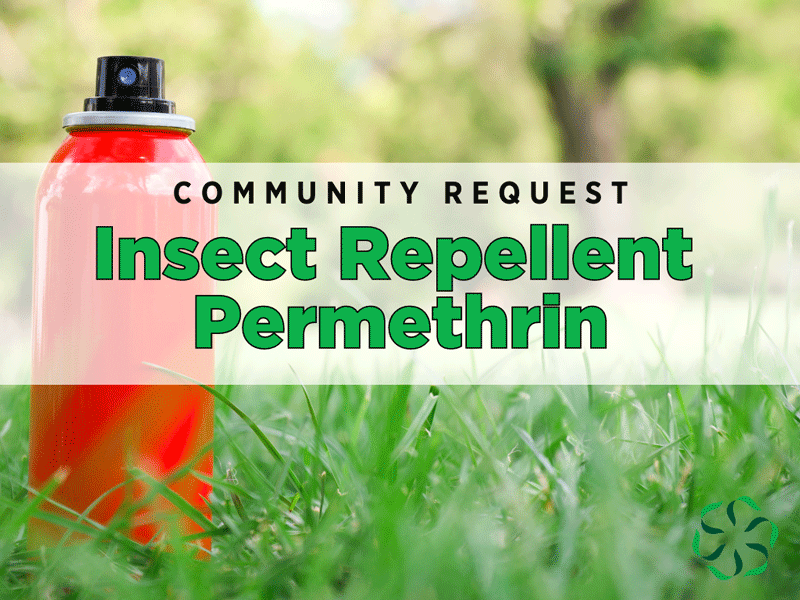In this post, we look at a community requested ingredient, Permethrin, a common insect repellent.
What are insect repellents?
Insect repellents are products that help prevent, repel, or mitigate pests. These can be products that we apply to our skin or products like lanterns or candles that use a heating mechanism to disperse repellents (1).
This post will focus on the community-requested ingredient permethrin, used as an insect repellent.
What do I need to know about insect repellents?
Manufacturers design different types of insect repellents to repel various insects. Disease-carrying insects, specifically ticks and mosquitoes, are the most common targets of insect repellents.
The U.S. Environmental Protection Agency (EPA) is responsible for the regulation of insect repellents, including permethrin.
Do all insect repellents work?
There are two kinds of insect repellents:
- EPA-registered products that have been tested for efficacy and safety.
- Unregistered products that have been tested only for safety.
EPA-registered products are tested to ensure they repel mosquitoes and/or ticks and are safe when used as directed. The EPA recommends using these products when you’re trying to avoid disease-carrying insects.
Unregistered products are tested to ensure safety, meaning if someone uses the products, including vulnerable populations like children and pregnant women, the product is unlikely to cause undue harm. Unregistered products are not tested to ensure efficacy (1,2).
What is permethrin?
Permethrin is a synthetic chemical compound that belongs to the class of pyrethroids. Pyrethroids are synthetic versions of natural insecticides found in chrysanthemum flowers (1).
We find permethrin in many insecticides and insect repellents designed to deter or destroy insects (1). Permethrin is frequently used in the creation of pre-treated insect-repelling fabrics (1).
Permethrin is also used as a treatment for lice and scabies. However, this post will focus on its insect-repellent uses.
What does permethrin do?
Permethrin is commonly used to control and eliminate a variety of pests, including mosquitoes, ticks, fleas, mites, and lice. It acts by interfering with the nervous system of insects, leading to paralysis and eventual death. Permethrin is effective against both adult insects and their larvae (1,2).
Can permethrin cause adverse reactions?
Permethrin is minimally toxic to humans and most mammals when used as directed. It breaks down rapidly in the environment, especially when exposed to direct sunlight (1).
However, it is still important to follow safety instructions and avoid excessive exposure or ingestion.
Although rare, insect-repellent products, including permethrin, can cause some people to have skin irritation or reactions. In that case, you should wash the area to remove any product, discontinue use, and contact a medical professional if it is severe.
Can children, pregnant, and nursing people use permethrin without harm?
It’s best to consult with your medical doctor if you have concerns. However, when used as directed, permethrin is safe for most individuals, including children older than two months of age and pregnant and nursing people (1).
Is permethrin harmful to pets?
Cats are more susceptible to permethrin toxicity compared to other pets, such as dogs. This is due to their inability to metabolize or break down the compound effectively, as cats lack certain enzymes necessary for its processing (1).
Even small amounts of permethrin can pose a risk to cats, and exposure to concentrated permethrin products designed for dogs or other animals can be toxic to them. It is crucial to avoid using permethrin products meant for other animals on cats and to use cat-specific insect repellent products instead.
It’s best to use animal-specific insect repellent to ensure you are not accidentally harming your pet. Contact your veterinary for specific recommendations for your pet.
How is it best to use permethrin to prevent insect bites?
When used to deter unwanted insect bites, wearing permethrin-treated clothing and using a DEET-containing insect repellent is a recommended strategy to ensure you’re protected from biting insects.
While permethrin-treated clothing can provide effective protection against insect bites, combining it with additional insect-repellent products can further enhance your overall protection.
Can I wash permethrin-treated clothes with my regular clothing?
It’s recommended to wash permethrin-treated clothes and fabrics separately from your everyday clothes. While permethrin breaks down, small amounts can still be left on the clothing or deposited on other clothing, depending on the efficacy of your washing machine.
By maintaining a clear separation between permethrin-treated clothes and your regular clothing during the washing process, you can help ensure the longevity of the treated clothing’s insect-repellent properties and reduce the risk of unwanted exposure or transfer of the insecticide to other garments.
What else do I need to know about permethrin?
Permethrin products are available in various formulations designed for specific purposes. It’s crucial to carefully read the directions and ensure that you are using the appropriate product for your intended use.
For example, permethrin designed for treating fabrics or clothing, is different from the formulation meant for direct application on the body. Using the wrong formulation can lead to ineffective results or adverse health outcomes like skin irritation.
The good news.
Permethrin is a safe and effective choice when it comes to keeping biting insects at bay. With its low toxicity to humans and mammals when used as directed, you can use permethrin products without worrying about adversely impacting your health.
If you have any questions about foods and ingredients, please reach out to us on Twitter, send us an email, or submit your idea to us at go.msu.edu/cris-idea.

